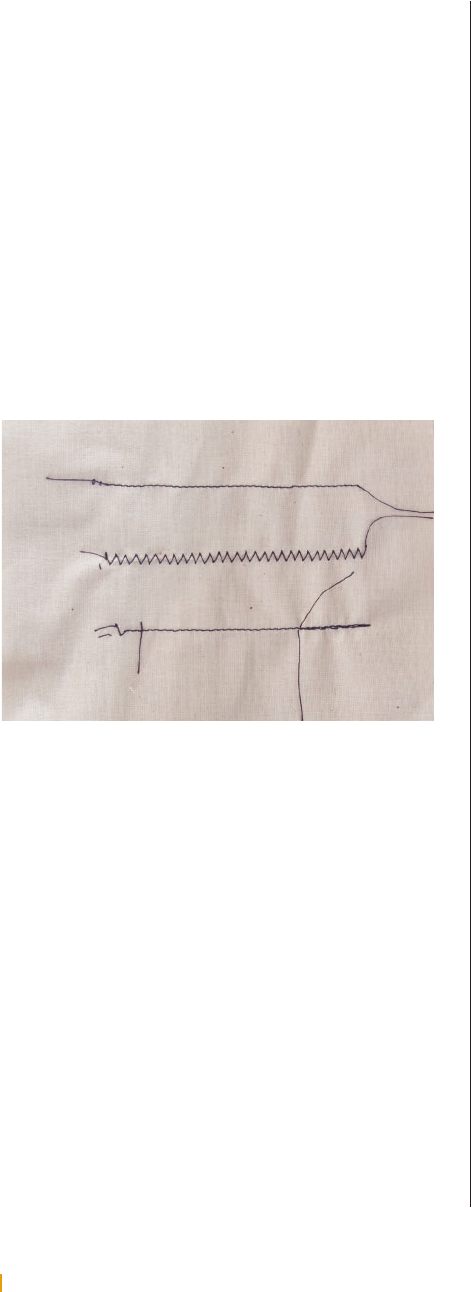
(RAY)
(Fogra 39) Job:02-28051 Title:RP-Textile Artist Handbook
#175 DTP:225 Page:142
138-151_28051.indd 142 3/6/12 8:54 PM
(RAY)
(Fogra 39) Job:02-28051 Title:RP-Textile Artist Handbook
#175 DTP:225 Page:143
138-151_28051.indd 143 3/6/12 8:54 PM
(Text)
THE TEXT ILE ARTI ST' S S T UDIO HANDB OOK
142
SEWING, QUILT ING,A ND APPLIQ UÉ
Whipstitch
A whipstitch (also known as a blanket stitch) is used
for binding or nishing edges. You can nish a single
edge of fabric or bind two edges together because
the thread wraps around the fabric edge(s).
Backstitch
The backstitch is a stitch that looks like one continu-
ous line, with no breaks (unlike the straight stitch,
which has breaks). It is used for embroidering or dec-
orative stitching, finishing, and because it is such a
strong stitch, for construction.
The Basics of Machine Sewing
As long as you can sew a straight stitch forward and
in reverse and a stretch stitch, you can sew anything.
Straight Stitch
The straight stitch is used to sew woven fabrics. Ad-
just the length of the stitch for temporary (basting)
stitches or for construction stitches, which are typi-
cally shorter than basting stitches.
Reverse Stitch
By sewing in reverse at the beginning and end of a
seam, you lock the stitches so they don’t pull out or
come undone. Every machine has a button, lever, or
dial that instructs the machine to sew in reverse.
Zigzag Stitch
Another basic stitch common to almost all sewing
machines, the zigzag is used for edge finishing and
for sewing knit fabrics. The stitch has built-in stretch,
so it is ideal when working with fabrics that stretch.
Sewing a Plain Seam
1. Raise the needle to the highest position and lift
the presser foot. Position the fabric layers, with the
raw edges aligned, under the presser foot so the
cut edges align with the
1
⁄2” (1.3 cm) or
5
⁄8” (1.6 cm)
seam allowance markings on the bed of the ma-
chine. The width of the seam allowances depends
on the project and the instructions usually indicate
the appropriate seam allowance width.
2. Lower the presser foot and hold the threads out
behind the needle. Take two or three stitches and
adjust the machine to sew two or three stitches in
reverse. Backstitch to the edge of the fabric and
switch the machine to stitch forward again.
3. Continue stitching, with the cut edges along the
seam allowance marking, to the end of the seam.
Backstitch again for about
1
⁄2” (1.3 cm). Raise the
presser foot and pull the fabric out. Cut the threads
to remove the fabric.
4. Press the seam and trim the seam allowances.
Running Stitch
Zig zag stitch
Reverse stitch
Depending on your home sewing
machine, you can create a number of
intricate stitches. Running, zig zag,
and reverse stitches are standard to
any machine and have specific uses
that make your sewing better.
(RAY)
(Fogra 39) Job:02-28051 Title:RP-Textile Artist Handbook
#175 DTP:225 Page:142
138-151_28051.indd 142 3/6/12 7:32 PM
(Text)
THE TEXT ILE ARTI ST' S S T UDIO HANDB OOK SEWING, QUILT ING,A ND APPLIQ UÉ
143
Tutorial: French Seams
instructions:
1. Press the fabric with the iron set on a
heat setting appropriate for the fiber con-
tent (high for cottons, low for silks, etc).
2. Pin the fabric layers with the wrong sides
together, and sew them together with
1
⁄2” (1.3 cm) seam allowances (see page 140).
[a, b]
3. Trim the seam allowances close to the
seam to about
1
⁄8” (3 mm). Trim the threads
as well. Use sharp fabric scissors so that
the cut edge is very clean and threads are
not snagged. [c, d]
French seams are specialty
seams, perfect for delicate
fabrics that unravel easily
and for times when you
don’t want to see the seam
allowances. It is an enclosed
seam and a professional way
to finish the raw edges inside
the garment or project.
tools
• Sewing machine
• Straight pins
• Sharp fabric scissors
• Iron and ironing board
materials
• Fabric and matching thread
This Singer home machine is a great
one to learn on, but you can also keep
it for years to come and advance your
skills with it. A good machine is a very
worthwhile investment.
A
B
C
D
(RAY)
(Fogra 39) Job:02-28051 Title:RP-Textile Artist Handbook
#175 DTP:225 Page:143
138-151_28051.indd 143 3/6/12 7:32 PM
Get The Textile Artist's Studio Handbook now with the O’Reilly learning platform.
O’Reilly members experience books, live events, courses curated by job role, and more from O’Reilly and nearly 200 top publishers.

